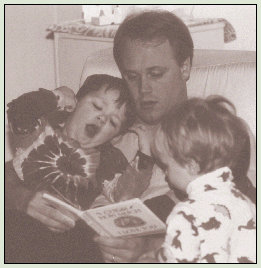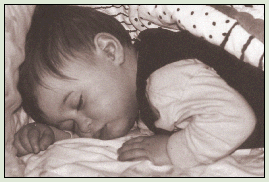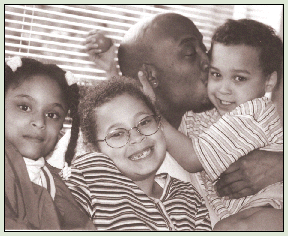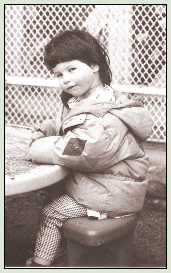
Section Two
Stories
- The Power of Stories
- Selected Parent and Child Care Provider Stories with Core Themes and Compelling Forces
- Summary of Core Themes
 The Power of Stories
The Power of Stories-Muriel Rukeyser
Stories have the power to heal and to change. In each story of this study there is truth from the respondent's perspective about something that works for LGBT parents and their children. Change can be achieved by identifying what works and focusing energy on doing more of it.
The interview protocol designed by the research team was guided by three lines of inquiry:
- When and where has this phenomenon been at its best in this organization?
- What are the organizational factors or practices that make this phenomenon possible?
- What are the possibilities which will enhance or maximize the potential for continued excellence?
The following stories were selected for inclusion in this report because they are the best examples of stories having identifiable themes and compelling forces. Themes and compelling forces may be actions, events, persons, the environment-any factors that cause the positive experience expressed in each story. The themes and compelling forces listed after the 13 stories which follow were identified by the researchers and participants at the Community Summit and WAEYC Conference.
Please refer to Appendix C and D to review the interview questions used to gather stories from parents and child care providers.
Selected Parent and
Summary
Core Themes
Child Care Provider Stories
Story One ~ The Trumpet Swan Triumphs
To let me know a little bit more about the child care situation you have, think about a day when everything about your child care arrangement really worked for you and your child-a day when you felt particularly satisfied at the end of the day. Tell me the story of that day.
The year before my daughter was in preschool, I had just come out. I had separated from my husband. He was very angry, outing me at school. He was concerned that my being lesbian would be harmful to the children. At the time I was not yet comfortable. However, at school I felt support. No one commented or said anything, but there was a newsletter that helped a lot. Have you ever read E.B.White's A Trumpet Swan? He also wrote Charlottes's Web. Anyway, the book is about a trumpet swan that is disabled. This particular trumpet swan is mute, which is a pretty difficult thing for a trumpet swan. The trumpet swan triumphs over this and falls in love with a female swan. The teacher had switched the pronoun! The trumpet swan who is usually seen as male was now female. Besides doing this incredible, triumphant thing of overcoming adversity, she also falls in love with a female swan. The teacher explained in the newsletter why she switched the pronoun and read the story to the class that way. I felt so happy reading this! I went to her and "came out." I told her how much the article meant to me.
Emergent Themes/Compelling Forces:
As told by a mother new to her lesbian identity and recently divorced.
Teacher's creativity in changing pronouns to reflect a different possibility
Story Two ~ We Inch "Out" a Little Bit More
Think about a time when you felt especially proud of your child's center, teacher or staff-when you felt pleased to be associated with them. Tell me what happened that led you to feel such pride.
Well that was what I was just talking about! When the infant teachers put up that poster (LGBT welcoming poster). It was like a turning point. Well, actually the turning point was when the center started to include me as a family-that emergency with my partner-and I had to start picking our daughter up. Knowing the center supported me as my daughter's other mom has made all the difference for me. I feel included and connected and very proud. I was expecting a negative reaction, because where I'm from that would never have happened. I'm proud of the administrator also. She has come out to some parents at a Parent Meeting and has shared much more about her own life. I quess it's been a growing process for all of us. As we inch out a little bit, then she does also and people react positively. . . and we inch "out" a little bit more! It's becoming like an extended family here.
Emergent Themes/Compelling Forces:
As told by a lesbian mom whose child attends a Seattle child care program.
Story Three ~ Well, I Have Two Moms and You Only Have One
Tell me about a time when a child or children in your care had an exciting discovery, learning moment, or story to tell you about diversity or honoring differences.
I remember a time when one of the children was giving another child a bad time about not having a dad. I was really worried about the child's feelings being hurt. Then he looked over at the kid and said really calmly, "Well, I have two moms and you only have one." It was a real eye-opener for me that this child had enough self-esteem that he could come back with something like that.
Emergent Themes/Compelling Forces:
As told by a European American man who is the owner/director of a center in North Seattle.
Story Four ~ Two Moms Just Like You!
Think of a time when you felt a rewarding sense of working in partnership with a lesbian, gay, bisexual or transgender parent in support of their child's development. Tell me about that time.
Emergent Themes/Compelling Forces: We had one openly lesbian family in the older class. The children had few questions; they just "got it." Early in the year the children were introduced to a persona doll family. "Toby" had a mom and a mamma. The first time the children met "Toby" and his moms, one of our lesbian parents was part of the circle time and her son was snuggled on her lap. As soon as they met this persona family, one child said, "Two moms, just like you!" as he pointed to his friend sitting in his mother's lap. The mother and child looked proud. More importantly, the other children were very excited to meet another two mom family. Throughout the year we used the persona dolls to represent many family situations that the class felt a need to discuss.
We had one openly lesbian family in the older class. The children had few questions; they just "got it." Early in the year the children were introduced to a persona doll family. "Toby" had a mom and a mamma. The first time the children met "Toby" and his moms, one of our lesbian parents was part of the circle time and her son was snuggled on her lap. As soon as they met this persona family, one child said, "Two moms, just like you!" as he pointed to his friend sitting in his mother's lap. The mother and child looked proud. More importantly, the other children were very excited to meet another two mom family. Throughout the year we used the persona dolls to represent many family situations that the class felt a need to discuss.
As told by a gay affirming director of a co-op in Seattle.
Story Five ~ All Families Are Welcome
Tell me about a time when you had an experience with or learned something about lesbian, gay, bisexual and transgender families that helped you feel more connected with their children.
I took a class last quarter. It was an anti-bias class at North Seattle Community College. In that class I read an article called "Katie Has Two Moms." That article made me really stop and think. I was struck by all that we do that is biased toward having a mom and a dad. All our applications say "mom" and "dad." I began to think about how our forms need to be more inclusive. The child may be living with two moms, an aunt or uncle, grandma . . . When a lesbian couple came to fill out our application form last year, they just crossed out "dad" and put "partner." Many of the single moms just cross it out. There are lots of ways we could be more sensitive. We could make the paper work more inclusive by updating the parent handbook, forms, applications and information sheets in the student files. We could have more books and discussions. We could be more sensitive and inclusive in the parenting classes we offer and on the parent board. I am currently trying to update our forms and the parent handbook. It isn't done yet. There is a poster in our hallway that says "All Families Are Welcome." It depicts a lesbian couple and a young child. My boss bought them for all of her centers to post. We had an "out" staff person who worked here years ago. She'd have loved the poster.
Emergent Themes/Compelling Forces:
As told by a center director/service provider for children of University students.
Story Six ~ We Are More Alike Than Different
Tell me about a time when you had an experience with or learned something about lesbian, gay, bisexual or transgender families that helped you feel more connected with their children.
One day after having a discussion with another African American woman about our experiences around black culture, she came out to me. We also discussed experiences she and her children were having. It caused me to recall my own experiences with my children when they were small. I realized how similar our experiences were. I often had to soothe my children after they were called a name or excluded from games because they were black and they were girls. We related similar stories. We talked for several hours and I came away understanding that we are more alike than different. I've tried very hard to keep this story in front of me each day as I see our day care children doing what I call the separation dance of "You're so different from me so that makes me better than you." I address it immediately and we talk about it.
Emergent Themes/Compelling Forces:
As told by a director from South Seattle who is African American and lesbian.
Story Seven ~ Two Dads and a Little Boy
Think about a time when you felt a rewarding sense of working in partnership with lesbian, gay, bisexual or transgender parents in support of their child's development. Tell me about this time.
That's an easy one. We have a gay family with two dads and a little boy. One is Papa and the other is Dad. The first time I met them they were so interested in our center and what we do. They became very involved parents. A month after they were here we were in a neighborhood parade-it was a really hot day and not very many families showed up. But they both came with their son and I spent a lot of time watching them. What a neat bond they all had together. They were proud of our school. We got to talk quite a bit that day. It was a neat connection. They are both-for a lack of a better word-both such gentlemen. They really give that extra attention, both to their son and to the school. If I compare them to other dads at the school, they really stand out as special people.
Emergent Themes/Compelling Forces:
As told by a European American woman who is director of a large center in North Seattle.
Story Eight ~ To Someone Special
To let me know a little bit about the child care situation you have, think about a day where everything about your child care situation arrangement really worked for you and your child-a day when you felt particularly satisfied at the end of the day. Tell me the story of that day.
Emergent Themes/Compelling Forces: Our child care is in downtown Seattle near where we work. The center has a diverse group of boys and girls of other nationalities and cultures. We were looking for a provider that was both close to work and that had a diverse population because both of the boys are Cambodian. My partner is Japanese. When we were choosing the center however, sexuality wasn't an issue for us. Mostly we wanted diversity and warmth and closeness to work, although, if we had felt the least bit of adversity about our family we probably would not have chosen this center. A great day? It's just daycare. But overall each day is good. They made a plate with each of the kid's families on it and our son had both of us-his daddies on it. So, I trust that we are accepted. In fact, the center called us before the mother's day celebration and asked us how we would like to approach the issue. We told them to have our son simply write, "To someone special."
Our child care is in downtown Seattle near where we work. The center has a diverse group of boys and girls of other nationalities and cultures. We were looking for a provider that was both close to work and that had a diverse population because both of the boys are Cambodian. My partner is Japanese. When we were choosing the center however, sexuality wasn't an issue for us. Mostly we wanted diversity and warmth and closeness to work, although, if we had felt the least bit of adversity about our family we probably would not have chosen this center. A great day? It's just daycare. But overall each day is good. They made a plate with each of the kid's families on it and our son had both of us-his daddies on it. So, I trust that we are accepted. In fact, the center called us before the mother's day celebration and asked us how we would like to approach the issue. We told them to have our son simply write, "To someone special."
As told by bi-cultural gay dads parenting their two sons, ages two and four.
Story Nine ~ The Child Care Center That Would Be Gay Friendly
If you could wave a magic wand and change three things about your experience with child care that can significantly heighten the quality of child care and learning atmosphere for the children of lesbian, gay, bisexual and transgender parents, what would they be?
As told by a Native American lesbian mom with a child with special needs.
Emergent Themes/Compelling Forces:
Story Ten ~ I Mean They Say That Right in the Handbook!
Think about a time when you were pleased to see indications that your child's provider honors diversity and respects differences. Tell me about that.
I always look for diversity and respect in a place. I feel very strongly about it. When I first visited the center, I was looking at a book about a farmer and I noticed that the teacher had changed the pronouns in the book from he to she. It was really neat. He was also a presenter at workshops. He always told me how pleased he was that I was a part of his center. It was great to experience the other teacher getting books from the library about strong women, or about single parents, or kids of different races and cultures. She wanted each kid to bring pictures of their families. She was very responsive to my friend that I live with who is not exactly my partner, but is very involved in my child's life. She was always very welcoming to her. And the co-op has been great. In their policies and procedures they include not discriminating based on sexual orientation. They also have a section in their handbook on how to build an anti-bias curriculum in the center and there are parents working there all the time. In another part of the handbook they talk about language-you know the way animals are always a "he" and we need to use a "she." I notice that they do change the pronouns a lot. They also tell parents to stretch the children's imaginations when they are playing and deciding who's going to be what-like when they're deciding who's going to be mommy and more than one wants to be the mommy-you can suggest that there are two mommies. I mean they say that right in the handbook! It's just so welcoming to me. I was told that these kind of ideas are talked about at interviews with the staff. I have felt so welcome and respected and that is probably the reason that there are other lesbian families there. The center also has posters up of all different kinds of families and books that are progressive-you know construction workers-half being women and half being men-that kind of thing.
Emergent Themes/Compelling Forces:
As told by an elementary school teacher and single parent lesbian mom.
Story Eleven ~ And of Course, We Changed It Right Away
Think of a time when you felt especially proud of your child care services, center, teachers and/or staff-when you felt pleased and grateful to be associated with them. Tell me the story.
We've worked hard on making our curriculum be more inclusive. And we've had parents, not especially lesbian and gay parents, point out to us when we weren't being very inclusive in our language. Like when we would do a unit on community helpers and were saying policemen.
Emergent Themes/Compelling Forces:
We used to have a cook who was lesbian. I was really proud when she pointed out to us that our personnel policy's non-discrimination statement did not include sexual orientation. And of course, we changed it right away. None of us had really noticed.
As told by a European American center director in North Seattle.
 Story Twelve ~ I Would Wave My Magic Wand
Story Twelve ~ I Would Wave My Magic Wand
If you could wave a magic wand and change three things that could add to the quality of child care and learning environment for lesbian, gay and bisexual parents and their children, what would they be?
As told by two gay dads with an adoptive son-both dads are "out" teachers living on the Eastside.
Emergent Themes/Compelling Forces:
Story Thirteen ~ I Got to Walk in the Parade with My Son
To let me know a little bit about the child care situation you have, think about a day where everything really worked for you and your child-a day when you felt particularly satisfied. Tell me the story of that day.
The most satisfying day I have had so far was a day when I was invited to my son's school for a parade. My ex-wife, my son's biological mother is also a teacher at his school. My appearance as a transgender parent is difficult for her and the other teachers, though not for my son. However, this particular day of the parade, my ex-wife asked me to come along and carry medicine for a little girl who has severe asthma attacks. This was an acknowledgement of my career and profession as a nurse. A child's needs were put before any other agenda . . . and I got to walk in the parade with my son . . . and even the principal thanked me for being there. This was a very satisfying day.
Emergent Themes/Compelling Forces:
As told by a transgender parent and nurse.
On three different occasions, researchers, parents and guardians, child care providers, teachers and community leaders came together. They read the 23 selected stories and identified patterns, themes, categories and compelling forces found in each story. The final goal was to cluster like themes together and to give each cluster a topic heading.
Each community meeting followed these steps in carrying out the tasks:
Themes and headings which emerged from each of the three community events were analyzed for similarities and differences. A final clustering of the themes and topic headings presented here are the stepping stones to future action and possibility.
1. Staff Awareness and Enlightenment
Each of the identified themes and clusters holds a seed of great potential for visioning a world of child care where children and families come first. These themes embody the best that is in child care. They now become the building blocks for what might be. They become the basis for "provocative propositions," written statements that provoke possibility for the future.
2. Family Pride and Self Pride
3. Non-Discrimination Policies, Procedures and Practices
4. Curriculum and Environment
5. Communication